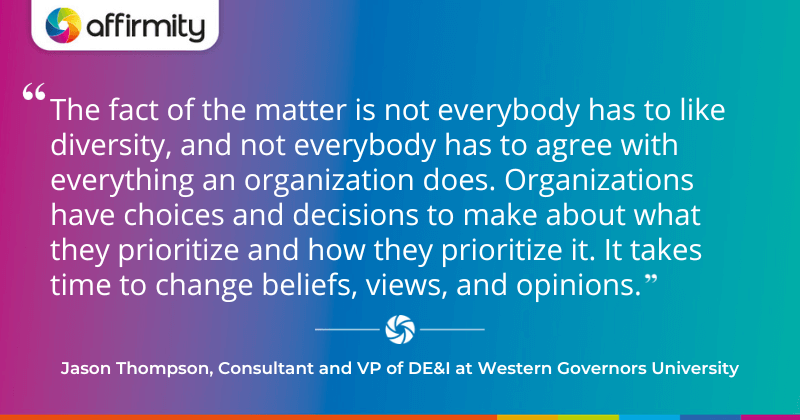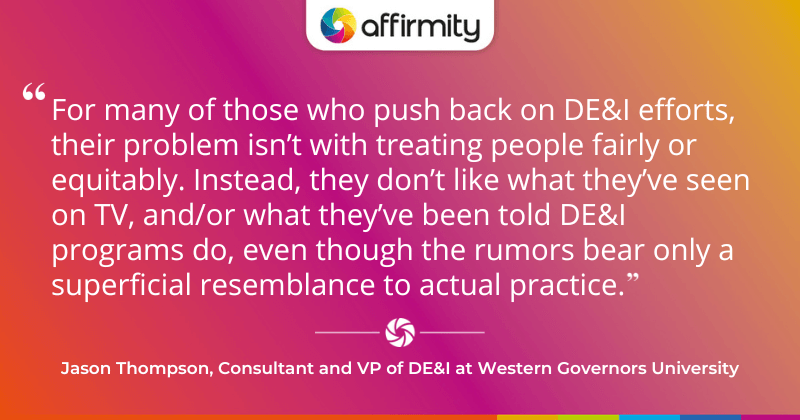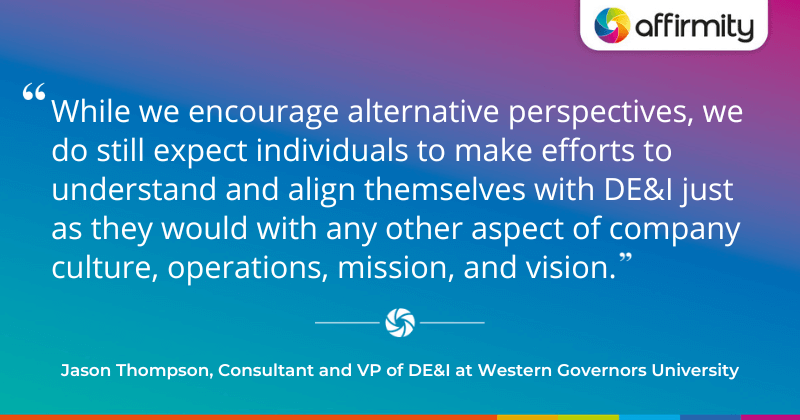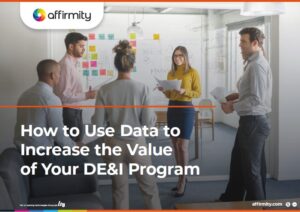Practitioners need to be able to deal with diversity, equity, and inclusion naysayers and use pushback as an opportunity to expand the conversation and re-energize their programs. Jason Thompson, VP of DE&I at Western Governors University, consultant, and a long-time Affirmity user and collaborator, talks us through the key steps to dealing with dissent.
1) Create an Environment Where DE&I Dissent Begins a Conversation
Dissent is a difference of opinion and a viewpoint that should be valued. As DE&I practitioners we must understand our own bias. Simply calling anyone who speaks out about not liking DE&I a “naysayer” can limit our ability to hear legitimate concerns. As we all know, not every DE&I workshop/training is a good one. Given the tendency for employee pushback to go unspoken, I’d encourage practitioners to view employees who do voice their concerns or dislike for DE&I work as an opportunity.

In some cases, I’ve found that people simply did not understand concepts like microaggression or privilege. These terms can be complicated, and polarizing. Many times, people only get a five-minute explanation of these concepts during a 45-minute session. Supposedly, that one 45-minute training session is meant to last for the rest of their lives (or at least until next year’s mandatory session). People need time and space to understand complicated concepts—no one learns calculus in one 45-minute session. As I always say, I cannot make you racist in 45 minutes, so we shouldn’t expect to undo racism, homophobia, antisemitism, or other forms of discrimination in a 45-minute session.
The fact of the matter is not everybody has to like diversity, and not everybody has to agree with everything an organization does. Organizations have choices and decisions to make about what they prioritize and how they prioritize it. Employees, too, are free to establish their own personal ethos and it takes time to change beliefs, views, and opinions.
We shouldn’t confuse attendance with behavior change: because of this, I have a policy of not doing mandatory training. I find that we get good participation because we don’t make it mandatory. The goal of DE&I is to create an inclusive work environment where everyone can thrive.
Therefore, we need to create environments where people can say they don’t like DE&I efforts. We should expect this sentiment as we’re asking them to be uncomfortable and talk about things they may not understand. We need to engage with dissent and encourage people to have a conversation.
DETAIL ON DE&I TRAINING TRAPS | ‘5 Ways to Protect Your Organization From Self-Sabotaging DE&I Training’
2) Share Goals Even Naysayers Agree With
For many of those who push back on DE&I efforts, their problem isn’t with treating people fairly or equitably. Instead, they don’t like what they’ve seen on TV, and/or what they’ve been told DE&I programs do, even though the rumors bear only a superficial resemblance to actual practice.
As DE&I professionals, we must hold ourselves individually accountable for tailoring our message in ways that help employees better understand what we’re trying to achieve as an organization. You could ask:
- Do you think we should have a workplace that’s respectful?
- Do you think we need to have a workplace where we don’t demean each other?
- Should we have a workplace that reflects the diversity of the world and the people the business serves?
The majority of the time, employees will agree to those principles. Unfortunately, naysayers may believe what they’ve heard in the media or from their friends: that diversity efforts encourage the hiring of unqualified people or force you to think a certain way. We need to help them separate reality from the myths. We want them to understand that businesses are working toward goals rather than quotas, and that they’re pursuing long-term organizational change rather than quick fixes that undermine the organization.
BRING DATA TO THE WHOLE ORGANIZATION | ‘How Affirmity’s TotalView Methodology Can Help You Maximize Management Visibility of AAPs’

3) Explain Why, and How DE&I Works and Give Practical Examples
Overall, it’s not hard to find information showing how or why diversity is important. In a recent Amazon Web Services-commissioned report, 90% of those surveyed reported they’d seen either a very positive or moderately positive impact from their DE&I program on their competitive position. Respondents also claimed their organization’s DE&I strategies were having a measurable positive impact in areas such as:
- Agility (83%)
- Recruitment and retention (84%)
- Customer engagement (84%)
- Company reputation (86%)
We must give due consideration to the practical application of DE&I to a company’s success. For example, I remember watching a documentary about the 1986 Challenger Space Shuttle disaster—a very public failure for NASA, that to this day is analyzed as much for the errors in the agency’s risk management and decision-making processes as it is for the actual technical issues that caused the accident. In this documentary, one of NASA’s scientists observed that when he first got to the agency, they hired the best scientists from across the country. Over time he observed that the agency began to hire from a more limited group of universities with the assumption that this ensured everyone had the same knowledge and skills.
He argued that this created a culture where scientists stopped questioning each other—and NASA’s own Office of Safety and Mission Assurance has since come to warn against “groupthink”, defined as a “mode of thinking that people in a group engage in where striving for unanimity overrides the motivation to realistically appraise alternative courses of action.”
The observation of this scientist and the finding of “groupthink” was not a diversity argument, but it’s an argument for the importance of diversity. Diversity creates a space where people have different ways of thinking and different views that can produce better outcomes as a result. It’s important that we question each other, avoid creating an echo chamber, and allow unique thinking to be in the room.

4. Be Clear It’s About Being Present, Not Perfect
As a DE&I practitioner, we play an important role in communicating how DE&I fits into the mission and vision of the organization, and that people are independently responsible for understanding it. So it’s important that we also communicate that, while we don’t expect everyone to be perfect advocates for DE&I, we do expect them to be present.
The way you’re “present” in any organization in which you intend to advance and thrive, is to make an effort to align yourself with the organizational mission and vision. While we encourage alternative perspectives, we do still expect individuals to make efforts to understand and align themselves with DE&I just as they would with any other aspect of company culture, operations, mission, and vision. We expect people to attend employee resource group events, or do their own independent research to better understand DE&I perspectives. Ultimately, naysayers who feel it’s not possible to align themselves with the mission and vision of the organization may need to choose employment opportunities that better suit them.
Some Closing Thoughts
As DE&I professionals, we shouldn’t be offended that naysayers exist. To me, the point of diversity is inclusive of the fact that there’ll be a diversity of views and we have to create a space for people to have the conversation. I’m glad that people feel empowered to say that they don’t quite get it—when people are silent, it’s actually more disturbing.
When I’ve encountered silence in my consulting work, I know there’s a deeper problem that will be tough to address. When people speak up, I can work with that. A high-functioning diversity program will have some tension. We must learn to navigate difficult conversations and provide data demonstrating our points and impact. Only then will we have buy-in from the top to the bottom of the organization.
MORE ON DE&I | ‘5 Self-Critical Questions That Help Organizations Support the Career Mobility of Marginalized Groups’
Discover Further Strategies for Improving Your DE&I Program: Download Our Guide
Prior to sharing these insights, Jason Thompson joined us for a discussion on the importance of intentional and measurable DE&I program creation. The resulting guide, “How to Use Data to Increase the Value of Your DE&I Program”, considers a range of practical, real-world examples and data-driven techniques. Check it out to discover:
- Why you should develop a data-driven DE&I strategy
- Why it’s important to set realistic goals and targets
- How organizations can use data to establish those goals and targets
- How organizations can hold leaders accountable for DE&I objectives
- What tools and practices are needed to manage DE&I efforts

Download the full guide today.
About the Author

Jason R. Thompson is a respected thought leader in diversity, equity, and inclusion (DE&I), as well as a long-time Affirmity partner and user. He has over 25 years of experience leading and building award-winning programs in multiple industries, including sports, healthcare, technology, and higher education.
Thompson has been quoted by The New York Times, and CNN, and was awarded the Inaugural DE&I Legacy Award from the Denver Business Journal. He is the co-founder of CAPE Inclusion, a minority-owned DE&I software solutions company, and writer of Diversity and Inclusion Matters: Tactics and Tools to Inspire Equity and Game-Changing Performance, a handbook for DE&I professionals, CEOs, and HR executives.
